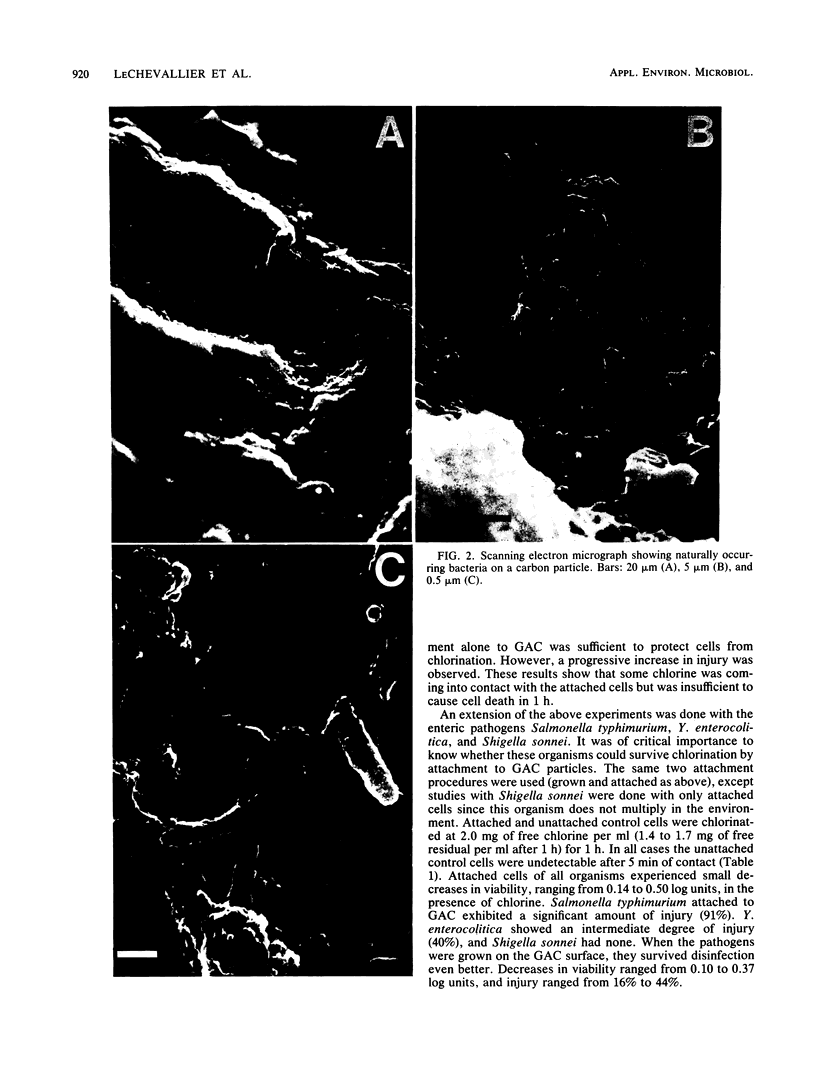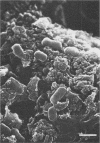Abstract
Heterotrophic plate count bacteria, coliform organisms, and pathogenic microorganisms attached to granular activated carbon particles were examined for their susceptibility to chlorine disinfection. When these bacteria were grown on carbon particles and then disinfected with 2.0 mg of chlorine per liter (1.4 to 1.6 mg of free chlorine residual per liter after 1 h) for 1 h, no significant decrease in viable counts was observed. Washed cells attached to the surface of granular activated carbon particles showed similar resistance to chlorine, but a progressive increase in sublethal injury was found. Observations made by scanning electron microscope indicated that granular activated carbon was colonized by bacteria which grow in cracks and crevices and are coated by an extracellular slime layer. These data suggest a possible mechanism by which treatment and disinfection barriers can be penetrated and pathogenic bacteria may enter drinking water supplies.
Full text
PDF





Images in this article
Selected References
These references are in PubMed. This may not be the complete list of references from this article.
- CHANG S. L., BERG G., CLARKE N. A., KABLER P. W. Survival, and protection against chlorination, of human enteric pathogens in free-living nematodes isolated from water supplies. Am J Trop Med Hyg. 1960 Mar;9:136–142. doi: 10.4269/ajtmh.1960.9.136. [DOI] [PubMed] [Google Scholar]
- Camper A. K., McFeters G. A. Chlorine injury and the enumeration of waterborne coliform bacteria. Appl Environ Microbiol. 1979 Mar;37(3):633–641. doi: 10.1128/aem.37.3.633-641.1979. [DOI] [PMC free article] [PubMed] [Google Scholar]
- LeChevallier M. W., Evans T. M., Seidler R. J. Effect of turbidity on chlorination efficiency and bacterial persistence in drinking water. Appl Environ Microbiol. 1981 Jul;42(1):159–167. doi: 10.1128/aem.42.1.159-167.1981. [DOI] [PMC free article] [PubMed] [Google Scholar]
- McFeters G. A., Cameron S. C., LeChevallier M. W. Influence of diluents, media, and membrane filters on detection fo injured waterborne coliform bacteria. Appl Environ Microbiol. 1982 Jan;43(1):97–103. doi: 10.1128/aem.43.1.97-103.1982. [DOI] [PMC free article] [PubMed] [Google Scholar]
- Neefe J. R., Baty J. B., Reinhold J. G., Stokes J. Inactivation of the Virus of Infectious Hepatitis in Drinking Water. Am J Public Health Nations Health. 1947 Apr;37(4):365–372. [PMC free article] [PubMed] [Google Scholar]






